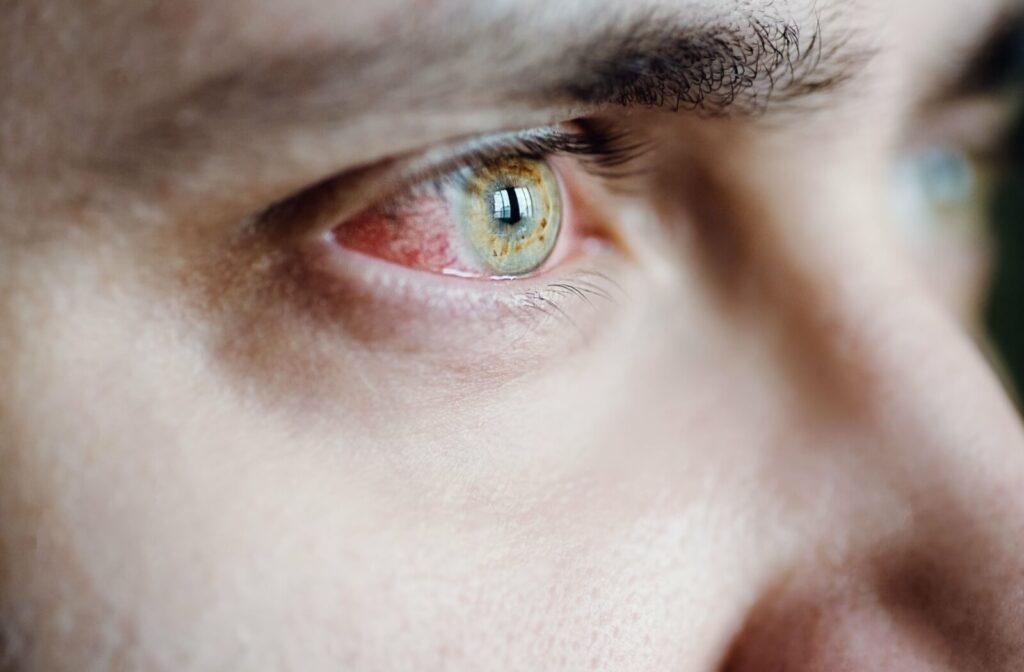We get a lot of questions about pink eye and how easily it can spread from person to person. It’s a common eye condition that can affect anyone, from children to seniors. Understanding how it spreads can help you keep your family’s eyes healthy.
Fortunately, pink eye is not typically contagious by air. But it can be very infectious, depending on its cause. The potential for transmission highlights the importance of an accurate diagnosis. It’s more likely to be passed on through direct contact with germs from an infected eye, though several other conditions are commonly misdiagnosed as pink eye.
What Is Pink Eye?
You’ve likely heard of pink eye, but what is it exactly? Pink eye, also known as conjunctivitis, is when the thin, clear tissue covering the white part of your eye & the inside of your eyelid gets inflamed.
Common Signs & Symptoms
- Redness in the white part of your eye
- A scratchy or gritty feeling, like sand is in your eye
- More tears than usual
- A sticky discharge that can be yellow, green, or white
- Crusty eyelids, especially when you wake up
- Blurred vision or sensitivity to light
Keep in mind, not every red eye is pink eye. Other conditions can cause similar signs, and it is helpful to understand the different causes of conjunctivitis. For a proper diagnosis, it’s a good idea to see your eye doctor.
How Pink Eye Spreads
You’ll be happy to know that you won’t get pink eye just by being near someone who has it because it isn’t typically spread through the air like a cold. While a cough or sneeze can release droplets, it’s much more likely to spread through direct contact with germs.
It Spreads Through Direct Contact
The most common way contagious pink eye spreads is by touching secretions from an infected person’s eye and then touching your own eyes. This spread can happen through close personal contact, like hugging.
It Spreads Through Surfaces
Germs from pink eye can live on surfaces for some time. You can pick it up by touching things like doorknobs or toys that have the germs on them, and then touching your eyes before washing your hands, as your eyes are a direct entry point for germs.

Different Causes of Pink Eye
Whether or not your pink eye is contagious depends entirely on what caused it. There are a few different types.
Viral and Bacterial Pink Eye
These types are very contagious. Viral pink eye is often linked to the common cold, while bacteria cause bacterial pink eye. It can be hard to tell them apart 2 just by looking, as they share many of the same symptoms.
Allergic Pink Eye
Allergic pink eye is not contagious. It happens when your eyes react to allergens like pollen, dust, or pet dander. If you have seasonal eye allergies, you might be more familiar with this type.
Pink Eye from Irritants
Pink eye from irritants is another type that’s not contagious. It occurs when something irritates your eye, such as smoke, chlorine from a swimming pool, or even a loose eyelash.
Protect Yourself and Others from Pink Eye
If you or someone in your family has pink eye, good hygiene is key to stopping it from spreading to others.
Practice Good Hand Hygiene
Wash your hands often with soap and warm water for at least 20 seconds. This attention to personal hygiene is critical after touching your eyes or face.
Don’t Touch Your Eyes
It can be tempting to rub scratchy eyes, but it’s essential to avoid it, as rubbing your eyes can cause damage. Touching your eyes can also introduce new germs or spread existing ones.
Don’t Share Personal Items
Avoid sharing anything that comes into contact with your eyes or face, including:
- Towels and washcloths
- Pillowcases and bedding
- Eye makeup and brushes
- Eyeglasses or contact lenses and their cases
Keep Surfaces Clean
Wipe down frequently touched surfaces like doorknobs, light switches, and phones with a household disinfectant, especially when someone at home is sick.
When to Visit Your Eye Doctor
While many cases of pink eye are mild and clear up on their own, it’s a good idea to have a professional take a look. Your eye doctor can determine the cause of your pink eye and suggest the right approach, which is just one of the many reasons to visit an optometrist.
Getting the proper diagnosis from your eye doctor helps you manage symptoms and protects your long-term eye health. Check in with a doctor for these signs:
- Severe pain in your eye
- Vision that is blurry or doesn’t improve
- Intense sensitivity to light
- Symptoms that seem to get worse instead of better after a few days
Talk About Your Symptoms with Us
Taking care of your eyes is an important part of your overall health. If you notice any signs of pink eye, getting a precise diagnosis can help you find relief and prevent it from spreading.
The team at Total Focus Optometry is committed to meeting your eye care needs with personalized attention. To have your eyes checked, reach out to your eye doctor in South Edmonton today.




